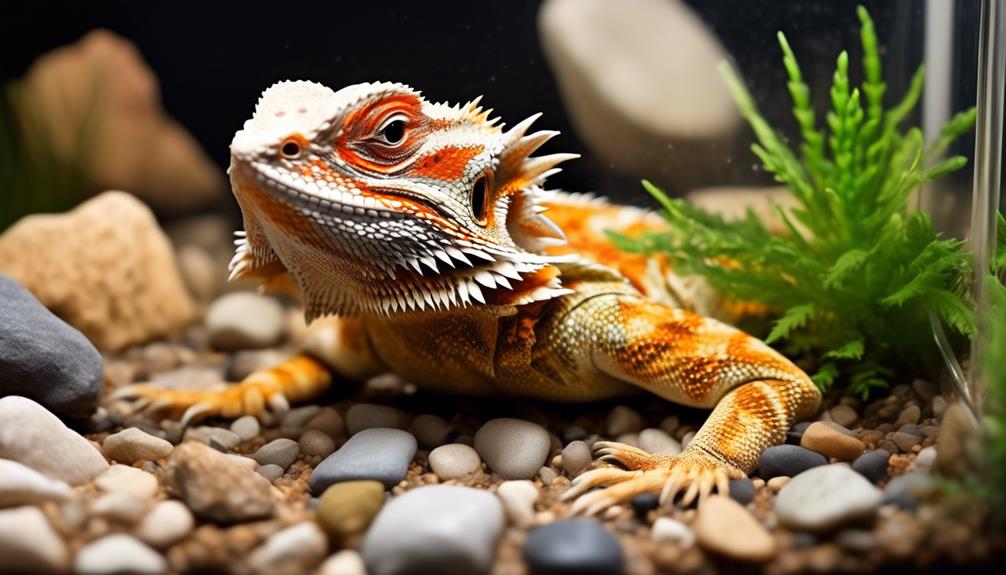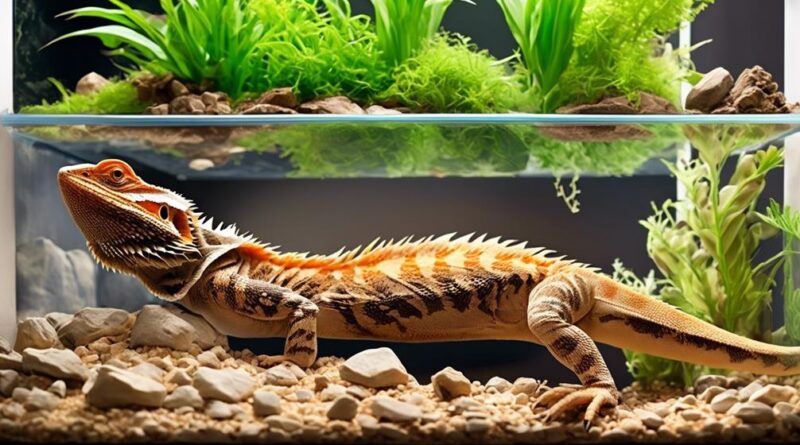What Do Bearded Dragons Need in Their Habitat?
Are you providing the best habitat for your bearded dragon?
Creating the right environment for your pet is essential for its health and well-being. From the selection of the enclosure to the heating and lighting setup, there are several key elements to consider.
Ensuring that these needs are met will contribute to a happy and healthy life for your bearded dragon.
Enclosure Selection
When choosing an enclosure for your bearded dragon, consider the size and material to ensure a comfortable and safe habitat. Size requirements are crucial for the well-being of your pet. A general rule of thumb is to provide at least 40 gallons of space for adult bearded dragons, with larger enclosures being even better. This allows for ample room for them to move around, explore, and bask under their heat lamp. Additionally, larger enclosures help create a more natural environment, reducing stress and promoting physical activity.
Ventilation needs are equally important. Ensure the enclosure has proper ventilation to maintain air circulation and prevent the buildup of humidity. A well-ventilated habitat helps regulate temperature and minimize the risk of respiratory issues. Look for enclosures with mesh or perforated sides to facilitate adequate airflow.
When it comes to material, opt for enclosures made of sturdy, non-toxic materials that are easy to clean. Glass terrariums and wooden enclosures are popular choices. Glass provides good visibility and insulation, while wooden enclosures offer excellent insulation and durability. Regardless of the material, ensure that the enclosure has secure locks to prevent any escape attempts and to keep other pets or children from accidentally opening the habitat.
Heating and Lighting
To ensure your bearded dragon's well-being, provide proper heating and lighting in their habitat.
Bearded dragons require a temperature gradient in their enclosure to regulate their body temperature effectively. The basking spot should be around 95-100°F (35-37.8°C) to mimic their natural environment, while the cooler end of the enclosure should be around 75-85°F (24-29.4°C). Achieving this temperature gradient allows your bearded dragon to move between warmer and cooler areas as needed for thermoregulation.
In addition to heat, UVB lighting is essential for bearded dragons as it aids in Vitamin D3 synthesis, which is crucial for calcium metabolism. Ensure that your bearded dragon's enclosure has a UVB light source that covers at least two-thirds of the enclosure. Position the UVB light around 10-12 inches from the basking spot to ensure proper exposure.
For the heat source, a ceramic heat emitter or a basking light can be used during the day, providing the necessary warmth for your bearded dragon. During the night, a low-wattage ceramic heat emitter can be used to maintain the ambient temperature without disrupting their day and night cycle.
Substrate Options
Consider using non-adhesive shelf liner or reptile carpet as substrate options for your bearded dragon's habitat. These options are ideal for maintaining the proper moisture levels in the enclosure, as they don't absorb moisture like loose substrates do. Loose substrates, such as sand or wood chips, can lead to impaction if ingested and can also harbor harmful bacteria if not cleaned frequently.
- Non-adhesive shelf liner and reptile carpet are easy to clean, reducing the risk of bacterial growth and ensuring a healthy environment for your bearded dragon.
- These substrate options are also safer for your pet, as they minimize the risk of impaction caused by ingesting loose substrates.
- By using non-adhesive shelf liner or reptile carpet, you can maintain the appropriate moisture levels in the habitat, crucial for your bearded dragon's health and comfort.
- Additionally, these substrate options require less frequent cleaning compared to loose substrates, saving you time and effort while ensuring a hygienic living space for your pet.
When considering substrate options for your bearded dragon's habitat, prioritize their safety and well-being. Opting for non-adhesive shelf liner or reptile carpet not only simplifies maintenance but also reduces potential health risks associated with loose substrates. By choosing the right substrate, you can create a comfortable and secure environment for your beloved reptile.
Decor and Hideouts
Create an inviting and stimulating environment for your bearded dragon by incorporating a variety of decor and hideouts within their habitat.
Naturalistic decor such as rocks, branches, and plants not only enhances the aesthetic appeal of the habitat but also provides opportunities for climbing, basking, and exploration. Be sure to select decor items that are safe for your bearded dragon, avoiding any sharp edges or toxic materials. Additionally, incorporating a variety of textures and shapes in the decor can offer sensory stimulation for your pet.
Secure hideouts are essential for your bearded dragon to feel safe and secure within their habitat. These hideouts can include reptile caves, hollow logs, or specially designed hides that allow your dragon to retreat and relax.
It's important to place these hideouts strategically throughout the habitat to offer your dragon options for thermoregulation and privacy. The hides should be appropriately sized, providing enough space for your bearded dragon to comfortably enter, turn around, and rest. Ensuring that the hideouts are secure and stable will prevent any accidental collapses that could cause stress or injury to your pet.
Feeding and Watering
After setting up an inviting habitat with decor and hideouts, the next crucial aspect to ensure the well-being of your bearded dragon is addressing their feeding and watering needs. Proper feeding and watering are essential for the health and happiness of your bearded dragon. Here are some important points to consider:
- Feeding Schedule: Bearded dragons thrive on a diet of live insects, leafy greens, and vegetables. Establish a feeding schedule to ensure they receive the appropriate nutrition. Young dragons may require daily feedings, while adults can be fed every other day. Providing a variety of food items will help maintain a balanced diet and prevent dietary deficiencies.
- Water Dish Placement: Place a shallow water dish in the enclosure to ensure your bearded dragon has access to fresh water at all times. The dish should be large enough for the dragon to soak in and positioned in a way that prevents tipping. Regularly clean and refill the dish to maintain hygiene and prevent dehydration.
- Supplements: Consider incorporating calcium and vitamin supplements into your bearded dragon's diet. Dusting their food with these supplements a few times a week can help prevent metabolic bone disease and other nutritional deficiencies.
- Monitoring: Keep an eye on your bearded dragon's eating and drinking habits. Any significant changes in appetite or water consumption could indicate an underlying health issue, so it's important to monitor these behaviors closely.
Temperature Regulation
Maintain optimal temperatures in your bearded dragon's habitat to support their health and well-being. Bearded dragons are ectothermic, meaning they rely on external sources of heat to regulate their body temperature. To facilitate thermoregulation, create a heat gradient within the habitat.
Provide basking spots at one end of the enclosure where your dragon can warm up, and cooler areas at the opposite end where they can retreat to lower temperatures. This allows them to move between different temperatures as needed to maintain their ideal body heat.
To achieve effective temperature control, use a combination of heat sources such as ceramic heat emitters, basking bulbs, or heat mats. These should be placed at one end of the habitat to create the basking area where temperatures range between 95-110°F (35-43°C). At the cooler end, temperatures should range between 75-85°F (24-29°C). It's crucial to monitor the temperatures regularly to ensure they stay within these ranges, as incorrect temperatures can lead to health issues for your bearded dragon.
In addition to providing the right temperature gradient, it's important to offer hiding spots and shaded areas within the habitat. This allows your bearded dragon to find refuge if they need to cool down.
Hygiene and Maintenance

To ensure a clean and healthy habitat for your bearded dragon, regularly clean and sanitize their enclosure and accessories. Maintaining a cleaning schedule is crucial to prevent the buildup of bacteria and odors, ensuring a safe and comfortable environment for your pet.
Waste disposal should be done promptly to avoid contamination and unpleasant smells. Sanitization methods such as using reptile-safe disinfectants and hot water can effectively eliminate germs and bacteria.
Habitat maintenance includes checking for any wear and tear in the enclosure and accessories, repairing or replacing them as needed to prevent any potential hazards to your bearded dragon.
- Establish a regular cleaning schedule to keep the habitat clean and hygienic.
- Dispose of waste promptly to prevent odor and bacterial growth.
- Utilize reptile-safe disinfectants and hot water for effective sanitization.
- Regularly inspect and maintain the habitat and accessories to ensure safety.
Behavioral Enrichment
Regularly providing behavioral enrichment for your bearded dragon is essential to ensure their mental and physical well-being. Bearded dragons, like all animals, have behavioral needs that must be met to keep them healthy and happy. Environmental enrichment and mental stimulation are crucial for their overall well-being. Bearded dragons are curious and intelligent creatures, and they thrive when provided with opportunities for enrichment activities.
To meet your bearded dragon's behavioral needs, consider incorporating various enrichment activities into their habitat. Providing different textures and surfaces, such as rocks, branches, and logs, can encourage exploration and climbing, mimicking their natural environment. Introducing new objects like non-toxic plants or tunnels can also stimulate their curiosity and provide mental stimulation.
Another effective way to provide behavioral enrichment is through interactive feeding methods. Instead of simply placing food in a dish, consider hiding it within the habitat or using puzzle feeders to encourage foraging behavior. This not only provides mental stimulation but also keeps your bearded dragon active and engaged.
In addition to physical enrichment, mental stimulation is equally important. Spending time with your bearded dragon outside of their enclosure, allowing them to explore new surroundings, can provide mental stimulation and prevent boredom.
Frequently Asked Questions
Can Bearded Dragons Live With Other Reptiles in the Same Enclosure?
Yes, bearded dragons can live with other reptiles in the same enclosure, but it's important to consider reptile compatibility and ensure there is enough enclosure space for each reptile to thrive without feeling overcrowded.
Are There Any Specific Plants or Natural Elements That Can Be Added to Their Habitat?
When setting up your bearded dragon's habitat, consider incorporating natural decorations like safe plants. This will provide habitat enrichment and environmental stimulation, making the enclosure a more engaging and enriching environment for your pet.
How Often Should Bearded Dragons Be Bathed and How Should This Be Done?
To properly care for your bearded dragon, it's important to give them regular baths. This helps with shedding and hydration. Use lukewarm water and gently swish it around to ensure they get properly hydrated.
What Types of Toys or Stimulation Can Be Provided for Bearded Dragons?
To keep your bearded dragon entertained, interactive toys like balls and tunnels can provide mental stimulation. Enrichment activities such as setting up obstacle courses or introducing new textures in their habitat can also keep them engaged.
Are There Any Common Household Items That Should Be Avoided in the Bearded Dragon Habitat?
When setting up your bearded dragon's habitat, be cautious about using common household items. Some materials like cedar and pine can be harmful. Opt for safe materials like reptile carpet or slate tiles as alternatives.
Conclusion
Overall, providing a proper habitat for your bearded dragon is essential for their health and well-being.
Make sure to choose the right enclosure, maintain proper heating and lighting, select appropriate substrate, and include plenty of decor and hideouts.
Additionally, ensure they have access to fresh water and a balanced diet.
By meeting all of these needs, you can create a comfortable and enriching environment for your bearded dragon to thrive in.
